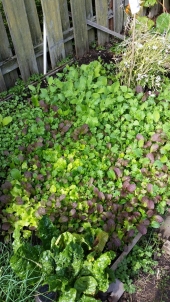

Most of my veggies self-seed here.
I love weeding extra growth of these non-weeds!!!
 Anni
Anni

Anyway I ask, having read what Patrick wrote if using shade and not letting some annuals seed if you think it maybe possible to perennialise annuals a part from brassicas.
I'll try to push this possibility on my land. I hope to be able to give some news in future writing to you.
I have kale sprouting up here and there all over, and it does much better if I just let it do its own thing. If it’s interfering with something else, I eat it. I use the edges of the guilds and some of the gaps waiting for the perennials to size up as areas in which to plant annuals, which demand more attention, sun, water, and nutrients, but are temporary placeholders. When something sprouts up unexpectedly, I try to respect its choice, because I figure nature knows better than I do. The annuals have a need to grow fast, produce seed, and die before the season ends; perennials are more likely to take their time, bloom earlier or later, reach deeper for water, have extended harvests. In late summer, the abundance is amazing! I pick what I can, offer some to friends and the local food bank, and leave the rest for wildlife. I no longer stress over picking every berry.
Some say my garden is total chaos. I say it’s “working.” What works or not is really a matter of perspective.
